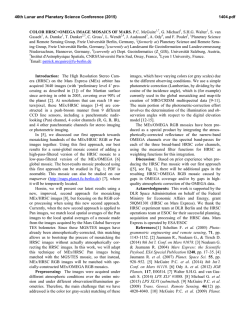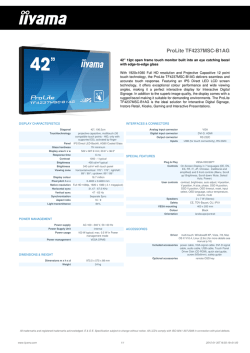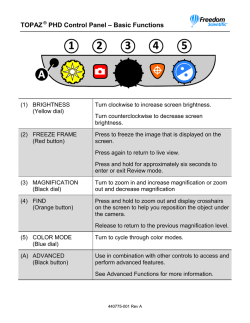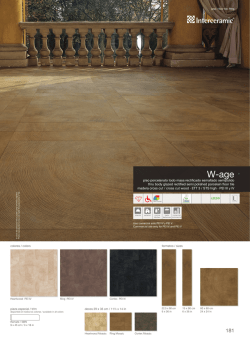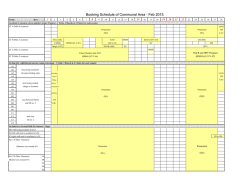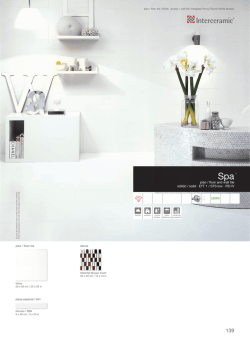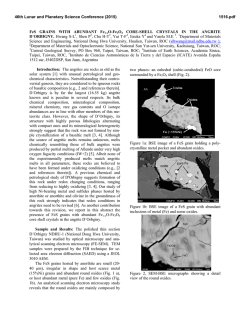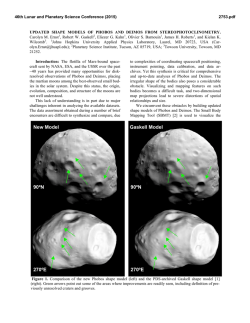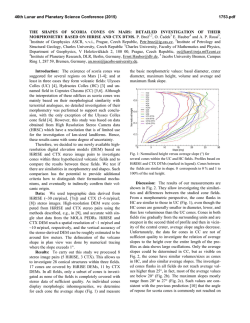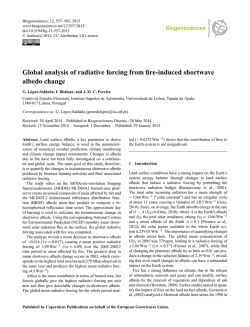
SYSTEMATIC PROCESSING OF MARS EXPRESS HRSC IMAGE
46th Lunar and Planetary Science Conference (2015) 2387.pdf SYSTEMATIC PROCESSING OF MARS EXPRESS HRSC IMAGE MOSAIC QUADRANGLES G. Michael, S. Walter, P. McGuire, T. Kneissl, S. van Gasselt, C. Gross, B. Schreiner, W. Zuschneid. Planetary Sciences and Remote Sensing, Institute of Geological Sciences, Freie Universitaet Berlin, Malteser Strasse 74-100, Haus D, Berlin 12249, Germany. Introduction: Mars Express HRSC image strips show varying brightnesses caused by differing illumination and atmospheric conditions. Lambert correction improves the situation [1], but not sufficiently for a visually consistent mosaic (Fig 1). plying a gaussian blur (without changing average spatial brightness characteristic). a b c Fig 2. a) TES b) Tied HRSC over TES c) Intermediate brightness reference Fig 1. After Lambert correction: strips generally have good internal illumination consistency, but atmospheric variability between strips remains strongly visible (the area shown is particularly difficult) There is not yet a systematically applicable correction for atmospheric effects for HRSC, which means that it cannot provide accurate information on surface albedo variations on scales greater than the image strip width. HRSC was conceived as a high resolution instrument, so this is not necessarily a problem: the global albedo of Mars at lower resolution is already well known, e.g. from TES [2], and if this is utilised as a brightness reference for individual HRSC strips, they can be brought into mutual consistency. Method: We construct the mosaic according to the following scheme: Step 1: Apply Lambert correction and map-project image strips (see [1]) Step 2: Create intermediate resolution brightness reference map (Fig 2). Divide HRSC strip into cells and tie local mean of HRSC pixels to local mean of equivalent area in albedo map (using a continuous interpolation). Mosaic at moderate resolution to obtain higher resolution brightness reference map with same average brightness characteristics as source albedo map. Eliminate remaining image edge artefacts by ap- Step 3: Create full resolution mosaic, tied to intermediate brightness reference map (Fig 3). Process images at full resolution, tying locally (and continuously) to intermediate brightness reference map, this time measured over smaller patches over each strip. Place into mosaic, feathering (i.e. fading from 0% to 100% transparency) over a narrow range of pixels. Note that feathering helps to hide the image boundary, but is only effective if the image brightnesses are well matched. a b c Fig 3. a) Tied HRSC over TES b) Intermediate brightness reference c) Final mosaic, 12.5 m/pix Step 4: Image sequence optimisation. Images are put into the mosaic in order of best ground sampling resolution (lowest to highest). In cases where this is not the optimal sequence (for reasons of quality or consistency) we manually construct a list of ordering relations. This is done by comparison of the assembled mosaic with individual image strips. 46th Lunar and Planetary Science Conference (2015) Step 5: Contrast recovery. A significant number of images show reduced contrast caused by increased atmospheric scattering, appearing in the processed mosaic as relatively flat bands. Contrast is recovered by stretching the histogram width by a factor of typically 1.5-6, the amount being adjusted iteratively after inspection of the assembled mosaic (Fig 4). a 2387.pdf morphological studies in the absence of a full correction of atmospheric effects (Fig 6). We have begun systematic processing of the complete HRSC dataset, working according to the USGS MC-30 quadrangle scheme. b Fig 4. a) Mosaic with overlaid very low contrast images 1903_0000 (left), 1892_0000 (centre) b) Mosaic including images 1903_0000, 1892_0000 with contrast increases of 6x, 5x Step 6: Colour processing. We have achieved some preliminary results in systematic processing of the colour channels using a similar technique, using a constant value for each colour channel instead of the brightness reference map, and restoring the larger scale brightness features by pan-sharpening the colour mosaic with that of the nadir channel (Fig 5). This means that colour differences are retained at local scales (less than the strip width), but not over longer distances, which may be sufficient for geomorphological interpretations at scales close to the resolution of the HRSC instrument. Fig 5. A colour mosaic including about 20 image strips in the Aram Chaos region Acknowledgement: We thank the HRSC experiment team at DLR Berlin and the Mars Express operations team at ESOC for their successful planning, acquisition and processing of the HRSC data. The work was supported by the German Space Agency (DLR Bonn), grant 50QM1301 (HRSC on Mars Express), on behalf of the German Federal Ministry for Economic Affairs and Energy. References: [1] Walter et al. (this conference, abs. #1434) [2] Christensen et al., J. Geophys. Res., 106, 23823-23871, 2001. Conclusion: We have shown that it is possible to produce a visually consistent image mosaic for geo- Fig 6. MC-11 Oxia Palus quadrangle composed from 184 image strips
© Copyright 2026
